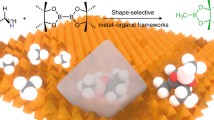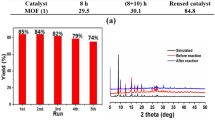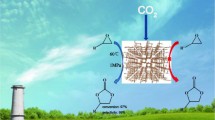Abstract
A highly selective Ir catalyst supported on the metal–organic framework (MOF) UiO-67 for the catalytic borylation of methane has recently been synthesized. The high chemoselectivity of the catalyst toward monoborylated methane (CH3Bpin, Bpin = pinacolborane) instead of diborylated methane (CH2Bpin2) was speculated to be caused by the steric confinement of MOF UiO-67. In this study, we applied quantum mechanical methods to determine: (1) the steric effect of the UiO-67 framework in promoting the chemoselectivity of the Ir catalyst toward CH3Bpin and (2) the borylation mechanisms over the Ir catalyst supported on UiO-67. Our results show that UiO-67 framework sterically obstructs the diffusion of the larger CH2Bpin2 molecule within the MOF while allowing the smaller CH3Bpin molecule to pass through with little energy penalty. The diffusion of CH2Bpin2 from the tetrahedral pore to the tetragonal pyramidal pore within modified UiO-67 with coordinated Ir(Bpin)3 complex has an estimated barrier of 24.7 kcal/mol and is 14.2 kcal/mol higher than the diffusion of CH3Bpin. The electronic and steric effects of the support at the Ir catalytic center are much smaller than this confinement effect on diffusion, and the catalytic center behaves similarly to the homogeneous Ir catalyst. We determined an overall free energy of activation of 34.6 kcal/mol for the CH4 borylation reaction using the Ir(III) catalyst. We also determined that the turnover-determining step for the catalytic methane borylation is the isomerization of seven-coordinated Ir(V) complex instead of the commonly assumed C–H bond activation by oxidative addition.












Similar content being viewed by others
Data Availability
Cartesian coordinates for all optimized models and complexes (in XYZ file format) and for periodic structures (in CIF file format), and DDEC bond order analysis outputs for complexes g and iso-g are provided in the OUTPUT file which may be opened as a text file. Detailed energy profiles for CH3Bpin and CH2Bpin diffusion in UiO-67 and for catalytic methane borylation cycles over the (phen)Ir(Bpin)3 complex, and verifications of the CP2K results are provided in the ESM file.
References
Cook AK, Schimler SD, Matzger AJ, Sanford MS (2016) Catalyst-controlled selectivity in the C–H borylation of methane and ethane. Science 351:1421–1424
Crabtree RH, Lei A (2017) Introduction: CH activation. Chem Rev 117:8481–8482
Gunsalus NJ, Koppaka A, Park SH, Bischof SM, Hashiguchi BG, Periana RA (2017) Homogeneous functionalization of methane. Chem Rev 117:8521–8573
Hartwig J (2016) Evolution of C–H bond functionalization from methane to methodology. J Am Chem Soc 138:2–24
Zhang X, Huang Z, Ferrandon M, Yang D, Robison L, Li P, Wang TC, Delferro M, Farha OK (2018) Catalytic chemoselective functionalization of methane in a metal–organic framework. Nat Catal 1:356–362
Cho S-H, Ma B, Nguyen ST, Hupp JT, Albrecht-Schmitt TEA (2006) A metal–organic framework material that functions as an enantioselective catalyst for olefin epoxidation. Chem Commun 37(24):2563–2565
Guo Z, Xiao C, Maligal-Ganesh RV, Zhou L, Goh TW, Li X, Tesfagaber D, Thiel A, Huang W (2014) Pt nanoclusters confined within metal–organic framework cavities for chemoselective cinnamaldehyde hydrogenation. ACS Catal 4:1340–1348
Madrahimov ST, Gallagher JR, Zhang G, Meinhart Z, Garibay SJ, Delferro M, Miller JT, Farha OK, Hupp JT, Nguyen ST (2015) Gas-phase dimerization of ethylene under mild conditions catalyzed by MOF materials containing (bpy)NiII complexes. ACS Catal 5:6713–6718
Ye R, Hurlburt TJ, Sabyrov K, Alayoglu S, Somorjai GA (2016) Molecular catalysis science: perspective on unifying the fields of catalysis. Proc Natl Acad Sci 113:5159–5166
Metzger ED, Comito RJ, Hendon CH, Dincă M (2017) Mechanism of single-site molecule-like catalytic ethylene dimerization in Ni-MFU-4. J Am Chem Soc 139:757–762
Ali-Mousa H, Amador RN, Martinez J, Lamaty F, Carboni M, Bantreil X (2017) Synthesis and post-synthetic modification of UiO-67 type metal–organic frameworks by mechanochemistry. Mater Lett 197:171–174
Hu Z, Zhao D (2017) Metal–organic frameworks with lewis acidity: synthesis, characterization, and catalytic applications. CrystEngComm 19:4066–4081
Kumar G, Das SK (2017) Coordination frameworks containing compounds as catalysts. Inorg Chem Front 4:202–233
Rogge SMJ, Bavykina A, Hajek J, Garcia H, Olivos-Suarez AI, Sepúlveda-Escribano A, Vimont A, Clet G, Bazin P, Kapteijn F, Daturi M, Ramos-Fernandez EV, Llabrés i Xamena FX, Van Speybroeck V, Gascon J (2017) Metal–organic and covalent organic frameworks as single-site catalysts. Chem Soc Rev 46:3134–3184
Bernales V, Ortuño MA, Truhlar DG, Cramer CJ, Gagliardi L (2018) Computational design of functionalized metal–organic frameworks nodes for catalysis. ACS Cent Sci 4:5–19
Xu W, Thapa KB, Ju Q, Fang Z, Huang W (2018) Heterogeneous catalysts based on mesoporous metal–organic frameworks. Coord Chem Rev 373:199–232
Wang C, An B, Lin W (2019) Metal–organic frameworks in solid–gas phase catalysis. ACS Catal 9:130–146
Smith KT, Berritt S, González-Moreiras M, Ahn S, Smith MR, Baik M-H, Mindiola DJ (2016) Catalytic borylation of methane. Science 351:1424–1427
Ahn S, Sorsche D, Berritt S, Gau MR, Mindiola DJ, Baik M-H (2018) Rational design of a catalyst for the selective monoborylation of methane. ACS Catal 8:10021–10031
Marenich AV, Cramer CJ, Truhlar DG (2009) Universal solvation model based on solute electron density and a continuum model of the solvent defined by the bulk dielectric constant and atomic surface tensions. J Phys Chem B 113:6378–6396
Kresse G, Hafner J (1993) Ab initio molecular dynamics for liquid metals. Phys Rev B 47:558–561
Kresse G, Hafner J (1994) Ab initio molecular-dynamics simulation of the liquid–metal–amorphous–semiconductor transition in germanium. Phys Rev B 49:14251–14269
Kresse G, Furthmüller J (1996) Efficiency of ab initio total energy calculations for metals and semiconductors using a plane-wave basis set. Comput Mater Sci 6:15–50
Kresse G, Furthmüller J (1996) Efficient iterative schemes for ab initio total-energy calculations using a plane-wave basis set. Phys Rev B 54:11169–11186
Perdew JP, Ruzsinszky A, Csonka GI, Vydrov OA, Scuseria GE, Constantin LA, Zhou X, Burke K (2008) Restoring the density-gradient expansion for exchange in solids and surfaces. Phys Rev Lett 100:136406
Blöchl PE (1994) Projector augmented-wave method. Phys Rev B 50:17953–17979
Øien S, Wragg D, Reinsch H, Svelle S, Bordiga S, Lamberti C, Lillerud KP (2014) Detailed structure analysis of atomic positions and defects in zirconium metal–organic frameworks. Cryst Growth Des 14:5370–5372
Hutter J, Iannuzzi M, Schiffmann F, VandeVondele J (2014) CP2K: atomistic simulations of condensed matter systems. Wiley Interdiscip Rev Comput Mol Sci 4:15–25
Perdew J, Burke K, Ernzerhof M (1996) Generalized gradient approximation made simple. Phys Rev Lett 77:3865–3868
Goedecker S, Teter M, Hutter J (1996) Separable dual-space Gaussian pseudopotentials. Phys Rev B 54:1703–1710
Grimme S, Antony J, Ehrlich S, Krieg H (2010) A consistent and accurate ab initio parametrization of density functional dispersion correction (DFT-D) for the 94 elements H-Pu. J Chem Phys 132:154104
Frisch MJ, Trucks GW, Schlegel HB, Scuseria GE, Robb MA, Cheeseman JR, Scalmani G, Barone V, Petersson GA, Nakatsuji H, Li X, Caricato M, Marenich AV, Bloino J, Janesko BG, Gomperts R, Mennucci B, Hratchian HP, Ortiz JV, Izmaylov AF, Sonnenberg JL, Williams-Young D, Ding F, Lipparini F, Egidi F, Goings J, Peng B, Petrone A, Henderson T, Ranasinghe D, Zakrzewski VG, Gao J, Rega N, Zheng G, Liang W, Hada M, Ehara M, Toyota K, Fukuda R, Hasegawa J, Ishida M, Nakajima T, Honda Y, Kitao O, Nakai H, Vreven T, Throssell K, Montgomery JA Jr, Peralta JE, Ogliaro F, Bearpark MJ, Heyd JJ, Brothers EN, Kudin KN, Staroverov VN, Keith TA, Kobayashi R, Normand J, Raghavachari K, Rendell AP, Burant JC, Iyengar SS, Tomasi J, Cossi M, Millam JM, Klene M, Adamo C, Cammi R, Ochterski JW, Martin RL, Morokuma K, Farkas O, Foresman JB, Fox DJ (2016) Gaussian 16 (revision A.03). Gaussian Inc, Wallingford
Zhao Y, Truhlar DG (2006) A new local density functional for main-group thermochemistry, transition metal bonding, thermochemical kinetics, and noncovalent interactions. J Chem Phys 125:194101
Cramer CJ, Truhlar DG (2009) Density functional theory for transition metals and transition metal chemistry. Phys Chem Chem Phys 11:10757–10816
Yu HS, He X, Truhlar DG (2016) MN15-L: a new local exchange-correlation functional for kohn–sham density functional theory with broad accuracy for atoms, molecules, and solids. J Chem Theory Comput 12:1280–1293
Weigend F (2006) Accurate coulomb-fitting basis sets for H to Rn. Phys Chem Chem Phys 8:1057–1065
Weigend F, Ahlrichs R (2005) Balanced basis sets of split valence, triple zeta valence and quadruple zeta valence quality for H to Rn: design and assessment of accuracy. Phys Chem Chem Phys 7:3297–3305
Yu HS, Fiedler LJ, Alecu IM, Truhlar DG (2017) Computational thermochemistry: automated generation of scale factors for vibrational frequencies calculated by electronic structure model chemistries. Comput Phys Commun 210:132–138
Pratt LM, Truhlar DG, Cramer CJ, Kass SR, Thompson JD, Xidos JD (2007) Aggregation of alkyllithiums in tetrahydrofuran. J Org Chem 72:2962–2966
Marenich AV, Jerome C, Cramer CJ, Truhlar DG (2012) Charge model 5: an extension of hirshfeld population analysis for the accurate description of molecular interactions in gaseous and condensed phases. J Chem Theory Comput 8:527–541
Kozuch S, Shaik S (2011) How to conceptualize catalytic cycles? The energetic span model. Acc Chem Res 44:101–110
Manz TA (2017) Introducing DDEC6 atomic population analysis: part 3. Comprehensive method to compute bond orders. RSC Adv 7:45552–45581
Mouarrawis V, Plessius R, van der Vlugt JI, Reek JNH (2018) Confinement effects in catalysis using well-defined materials and cages. Front Chem 6:623
Acknowledgements
The authors are grateful to Massimiliano Delferro, Omar K. Farha, and Connie C. Lu for many helpful discussions. This work was supported as part of the Inorganometallic Catalysis Design Center, an Energy Frontier Research Center funded by the U.S. Department of Energy, Office of Science, Basic Energy Sciences under Award DE-SC0012702.
Author information
Authors and Affiliations
Corresponding authors
Ethics declarations
Conflict interest
The authors declare that there is no competing interest.
Additional information
Publisher's Note
Springer Nature remains neutral with regard to jurisdictional claims in published maps and institutional affiliations.
Electronic supplementary material
Below is the link to the electronic supplementary material.
Rights and permissions
About this article
Cite this article
Yang, B., Wu, XP., Gagliardi, L. et al. Methane functionalization by an Ir(III) catalyst supported on a metal–organic framework: an alternative explanation of steric confinement effects. Theor Chem Acc 138, 107 (2019). https://doi.org/10.1007/s00214-019-2498-y
Received:
Accepted:
Published:
DOI: https://doi.org/10.1007/s00214-019-2498-y




